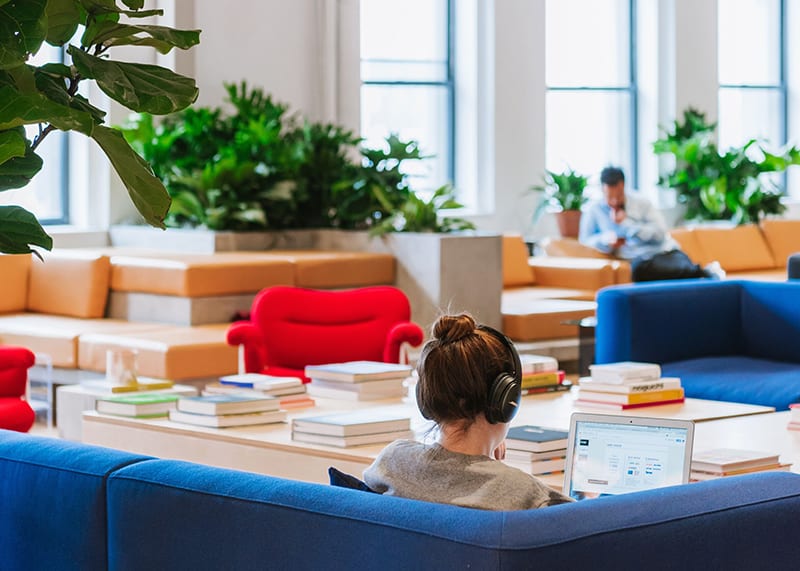Our collective global experience working from home during the global pandemic showed that, despite all our virtual tools, some level of face-to-face collaboration is needed in the long run. A study by workplace forum Blind showed that 56 per cent of employees report feeling more anxiety as a result of remote working, and 53 per cent said productivity has declined due to mental health issues from working from home.
Business leaders have speculated that permanent virtual work could lead to a decline in innovation and creativity, since we all miss out on the planned and spontaneous in-person interactions that spark them. Another consideration: studies show many employees would prefer to be back in the office for at least some of the week.
But bringing people back to the office during a pandemic will require brand-new workplace strategies. Offices need to be less dense so that employees can stay socially distanced. That means no more mega headquarters. Commutes will also have to be shorter and rely on less-crowded forms of transportation.
Benefits of the hub-and-spoke model
To satisfy these requirements, many companies are implementing a decentralised, or ‘hub-and-spoke’, model of the office. These companies may maintain a central headquarters that employees travel to less frequently, while simultaneously providing smaller, satellite offices spread across a city or even a country. In this model, what was once the main headquarters becomes less crowded, and may even be able to shrink in size.
‘Our enterprise tenants are telling us that they effectively need a hub-and-spoke model,’ WeWork CEO Sandeep Mathrani told CNBC. ‘The spokes need to be closer to where their employees live, to minimise the commuting time it takes to get to the office.’

With a hub-and-spoke model of office space, no single location gets overcrowded. And having spaces closer to where employees live makes their commutes less complicated.
‘The how and why of work is changing in significant ways, and employee expectations are also rapidly evolving,’ said Matt Jahansouz, chief people officer at WeWork. ‘Flexibility must be core to any company’s go-forward strategy, which means being able to leverage a broad portfolio of safe office solutions will become a vital part of returning to work.’
Here’s how WeWork is already employing this model in New York City.
A hub-and-spoke model in New York City
As an industry leader in office space, WeWork has implemented a hub-and-spoke model for our own employees in New York City. It’s an ideal place for this pilot: Research shows that 96 per cent of those living in Manhattan – and over 58 per cent of all office workers in the city – are within a 15-minute bike ride or walk of a WeWork.
Most of our employees used to work out of our central headquarters in Chelsea, in Manhattan (we call it Chelsea HQ). But the recent need to have satellite offices spread throughout the city led us to designate three other WeWork locations as flagship buildings. They are: Midtown at WeWork 620 Avenue of the Americas, Downtown at WeWork 85 Broad Street and in Brooklyn at WeWork Dock 72, Brooklyn Navy Yard.
We’re bringing our employees back gradually, using a staggered approach over three phases and several months, to ensure they can be at ease when they return. Having four satellite offices spread across New York City means employees can work from whichever one is closest to their home. In the first wave of bringing people back to the office, employees had access to the more than 160 WeWork spaces in New York City. In this phase, nearly half of employees elected to work from non-flagship locations and the other half from flagship ones.
Employees can come into Chelsea HQ less often than they used to, perhaps only for critical meetings. Commuting times are reduced and each location is less crowded, while also giving employees a chance to collaborate face-to-face. Spending time with teammates in-person also increases the chance of spontaneous interactions and creative connections.

The response to this hub-and-spoke model has been positive. ‘Returning to a dedicated office space gives me a place to focus, with fewer distractions,’ says Chris Serafino, senior manager of social media at WeWork. ‘Being in a space with others who are working pushes me into ‘get stuff done’ mode as opposed to playing fetch with my dog.’
Zachary Vaughn, associate director of property advisory at WeWork, has recently worked from four different WeWork locations: Chelsea HQ, 85 Broad, WeWork 880 3rd Avenue in Midtown East and WeWork 140 Crosby in Soho.
‘Whether I have a doctor’s appointment downtown or a meeting at HQ, or just want to sit with certain colleagues, I have the ability to access beautifully designed, ready-to-work space easily,’ said Vaughn. ‘WeWork’s massive portfolio allows me to choose office space that fits my daily needs.’
We’re focused on providing spaces that prioritise health and safety for our employees and members to return to, ones that are mindful of both their physical and mental safety. To that end, we have redesigned our spaces to be less dense, set up signs promoting social distancing, stepped up professional cleaning and updated our air-filtration systems in our spaces.
There’s no doubt that the office will continue to play an integral part in how we work. What that looks like, though, will be slightly different than before. The workplace of the future is one that fosters collaboration and innovation while prioritising health and flexibility. At WeWork, our intentional approach in supporting our employees as we all navigate this transition demonstrates that this is possible.







